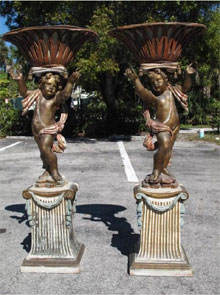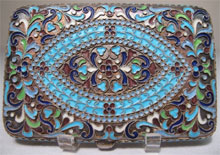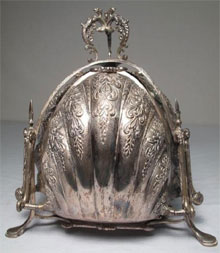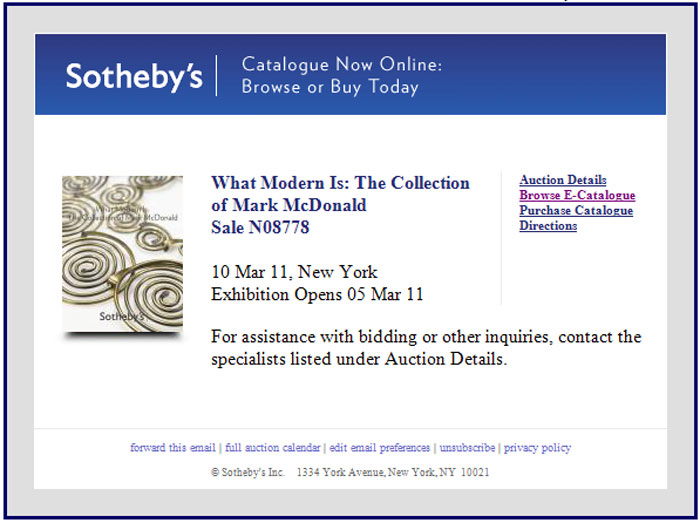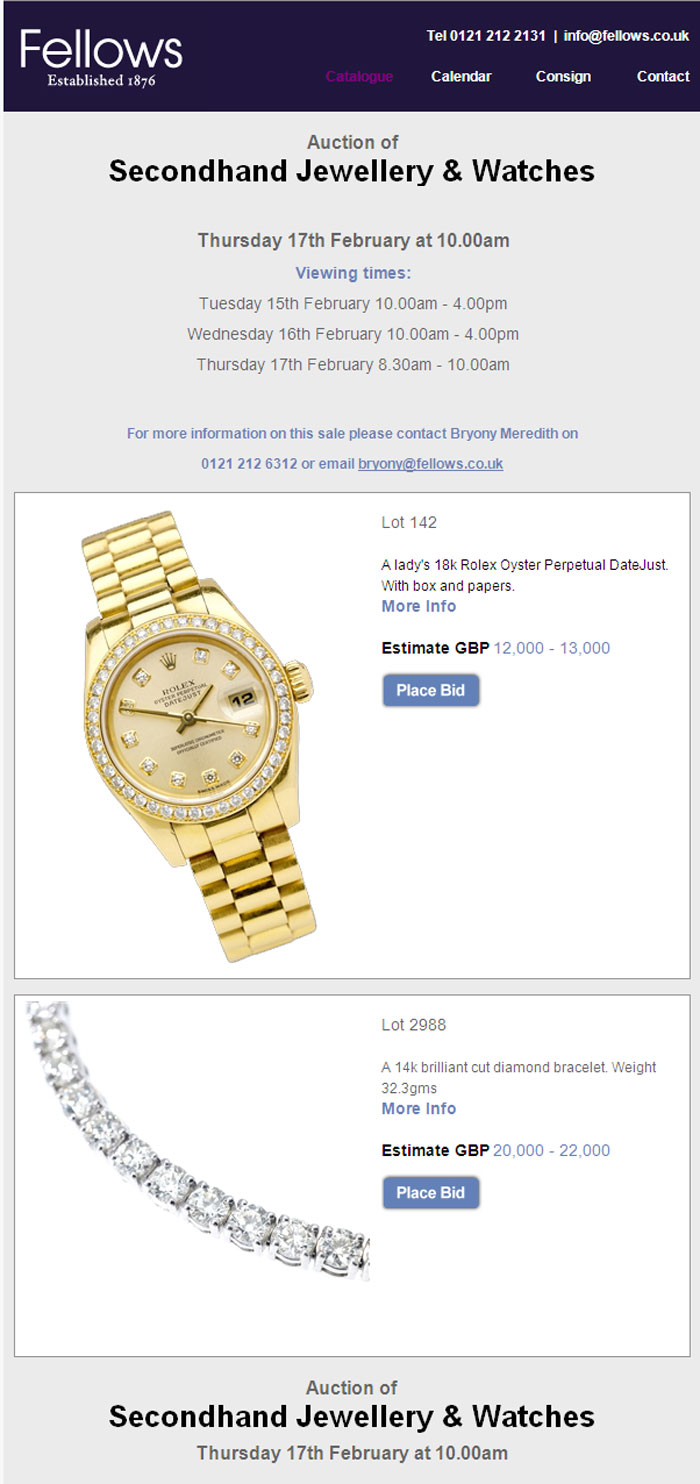18th-Century Aubusson Tapestry, Superior English Inlaid Tilt Table Poised for Success in Quinn’s March 5 Auction of International Fine Art, Furniture
February 28th, 2011 by adminFALLS CHURCH, Va. – While Washington, D.C., has long been a hive for international activity, the district’s suburb of Falls Church, Va., is where the fine art of many nations will be showcased on Saturday, March 5. That’s when Quinn’s Auction Galleries will host its 500-lot International Furnishings, Fine & Decorative Arts sale.
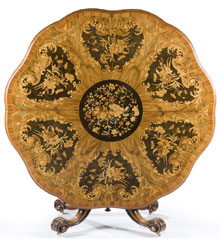
English walnut and marquetry inlaid tilt-top center table, mid 19th century, manner of Edward Holmes Baldock (English, 1777-1845). Estimate $8,000-$12,000. Quinn’s Auction Galleries image.
“The selection of fine art and furniture in this auction is, by far, the finest and most diverse we have ever offered,” said Quinn’s VP Communications & Marketing Matthew Quinn. “The main consignor is a Washington-area physician who has very refined taste and a preference for English furniture and Continental paintings.”
A premier piece from the doctor’s consignment is an 1850 English walnut with marquetry tilt-top table measuring 57 inches tall and 56 inches in diameter, crafted in the manner of Edward Holmes Baldock (English, 1777-1845). Supported by a deeply and ornately carved base, its cabriole-edge tabletop features panels decorated with a profusion of inlaid wildflower bouquets in natural-wood tones, and a central design of multicolored flowers and foliage.
“It is one of the best pieces of furniture ever to come to our gallery. The quality is just tremendous,” said Quinn, who related its history. “An interior designer had been brought in to furnish the doctor’s spacious residence and suggested decorating it with new furniture. The doctor didn’t like the idea, so he and his wife traveled to the UK and handpicked furniture for the home. According to the sales receipt, they bought the table from Butchoff Antiques in London on Feb. 4, 1999.” At Quinn’s auction, the table will be offered with a conservative estimate of $8,000-$12,000.

Circa-1850 Louis XV Aubusson fete champetre tapestry, wool and silk, 7 ft. by 12 ft., ex Mayorcas Collection of Tapestries and Textiles. Estimate $15,000-$25,000. Quinn’s Auction Galleries image.
Also from the physician’s residence comes an exquisite circa-1750 fete champetre Louis XV Aubusson tapestry after Jean-Baptiste Huet, 7 ft. by 12 ft. and titled Le Cheval Fondu. The wool and silk tapestry depicts a garden party, with four young men engaged in a game, and a woman sitting with a child on a log, all against a densely detailed background of trees. Provenance: The Mayorcas Collection of Tapestries and Textiles, Christie’s, Feb. 12, 1999, Lot #7. It is estimated at $15,000-$25,000.
An 1876 gilt-framed Gustave Colin (French, 1828-1910) Impressionist oil on canvas of a French village is signed and dated by the artist. Colin’s mastery in creating the illusions of light and shade is amply evident in his depiction of a stately tree that towers above villagers in and around a town park. The 29- by 38-inch (sight) painting is expected to fetch $15,000-$20,000.

Jose Gurvich (Lithuanian/Uruguayan, 1927-1974), Puerto de Montevideo, 1950, oil on canvas, 19 by 16 inches (sight). Estimate $13,000-$15,000. Quinn’s Auction Galleries image.
The European art lineup continues with a painting from a different consignor – a Jaroslav Vesin (Bulgarian, 1859-1915) oil-on-canvas depiction of two horses pulling a primitive sled against a bleak wintry setting. A driver commandeers the horses past a snow-covered mill house as two bundled-up female passengers share an animated exchange from their seat in the sleigh, giving the viewer much to study in the well-executed 19¼- by 29½-inch (sight) painting. The presale estimate is $10,000-$15,000, but as Quinn remarked, “It has the potential to do much better. The subject matter is quite desirable in today’s marketplace, and its quality is obvious.”
A previously unpublished screenprint of an Andy Warhol painting titled Orchids could end up being the sale’s “sleeper.” Accompanied by a letter of authenticity from The Andy Warhol Art Authentication Board Inc., it carries a $5,000-$8,000 estimate. “Prints of Warhol’s known works can brings in the tens of thousands of dollars,” Quinn said. “This print was unpublished, so it could be very intriguing to collectors.”
Two paintings by Lithuanian/Uruguayan artist Jose Gurvich (1927-1974) will be auctioned. One of them, a 1950 Montevideo port scene, is signed and dated by the artist and estimated at $13,000-$15,000.
Other artworks to be auctioned include an 1874 oil-on-canvas painting of Shakespeare’s tragic character Ophelia, by Tomkins Harrison Matteson (American, 1813-1884); and a work by the noted African-American folk artist Clementine Hunter (circa 1887-1988).
While Albert-Ernest Carrier-Belleuse’s (French, 1824-1887) bronzes are more commonly seen at auction than his works in other media, many collectors are enamored of his terra cotta figures, like the one in Quinn’s upcoming sale titled Amazone Captive. The subject is a nude maiden chained to a tree stump with arrows, a shield and helmet alongside her. Estimate $8,000-$12,000.

Madoura/Pablo Picasso (Spanish, 1881-1973) earthenware pitcher, Cavalier and Horse, 8¾ inches high, circa 1952, 28/300, Madoura Plein Feu pottery stamps. Estimate $4,000-$6,000. Quinn’s Auction Galleries image.
A wonderful example of Picasso pottery to be offered is a painted earthenware pitcher titled Cavalier and Horse. Standing 8¾ inches high, the piece was made around 1952. Under its base, it has an impressed Madoura mark and in black paint, the words “Edition Picasso 28/300.” According to Matt Quinn’s research, only a few of its type have been offered in major auctions in the last 10 years. Estimate $4,000-$6,000.
Among the many other items included in the March 5 auction are: English plant stands, an étagère, music cabinet and circa-1800 chest on chest; 150+ Chinese snuff bottles from a Southern California collector, a Maria Montoya Martinez (Native American, 1881-1980) decorative pot in rarely seen red coloration, an early 19th-century Regency carved giltwood Ouroboros mirror, and three 18th/early-19th-century limestone garden ornaments. Additionally, the sale includes an 1860s repousse sterling silver tea kettle on stand in the Castle pattern and repousse silver service, both by S. Kirk & Son, Baltimore.
All forms of bidding will be available, including live via the Internet. For additional information, call Matthew Quinn at 703-532-5632 or e-mail matthew.quinn@quinnsauction.com. Visit Quinn’s online at www.quinnsauction.com.



